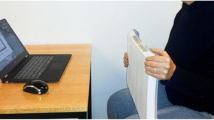Abstract
Background
Lower limb weakness is an important risk factor for fall accidents and a predictor for all-cause mortality among older adults. Unilateral whole-lower limb strength may be a better measure of fall risk than the bilateral measure. In addition, a number of clinical conditions affect only one leg, and thus this type of assessment is relevant in clinical settings.
Aim
To explore the intra-rater reproducibility of the Nintendo Wii Balance Board (WBB) to measure unilateral whole-lower limb strength and to compare the method with stationary isometric muscle apparatus (SID).
Method
Intra-rater test–retest design with 1 week between sessions. Thirty community-dwelling older adults (69 ± 4.2 years) were enrolled and examined for maximum lower limb strength in their dominant and non-dominant leg. Intraclass correlation coefficient (ICC) was calculated to describe relative reproducibility, while standard error of measurement (SEM), limits of agreement (LOA) and smallest real difference (SRD) were calculated to describe absolute reproducibility between test sessions. Concurrent validity with the SID was explored using the Pearson product-moment correlation coefficient (PCC).
Results
No systematic difference was observed between test sessions. ICC was 0.919–0.950 and SEM, LOA and SRD was 2.9–4.1 kg, 24.1–28.3 kg and 7.6–11.3 kg, respectively. Further, the PCC was 0.755 and 0.730 for the dominant limb and the non-dominant limb, respectively.
Conclusion
A high relative and an acceptable absolute reproducibility was seen when using the Nintendo Wii Balance Board for testing unilateral lower limb strength in community-dwelling older adults. The WBB correlated strongly with the SID.


Similar content being viewed by others
References
Morey MC, Pieper CF, Cornoni-Huntley J (1998) Physical fitness and functional limitations in community-dwelling older adults. Med Sci Sports Exerc 30:715–723. http://www.ncbi.nlm.nih.gov/pubmed/9588614
Norman K, Stobäus N, Gonzalez MC, Schulzke J-D, Pirlich M (2011) Hand grip strength: outcome predictor and marker of nutritional status. Clin Nutr 30:135–142. doi:10.1016/j.clnu.2010.09.010
Phillips P (1986) Grip strength, mental performance and nutritional status as indicators of mortality risk among female geriatric patients. Age Ageing 15:53–56. http://www.ncbi.nlm.nih.gov/pubmed/3953331
Newman AB, Kupelian V, Visser M et al (2006) Strength, but not muscle mass, is associated with mortality in the health, aging and body composition study cohort. J Gerontol A Biol Sci Med Sci 61:72–77. http://www.ncbi.nlm.nih.gov/pubmed/16456196
Fujita Y, Nakamura Y, Hiraoka J et al (1995) Physical-strength tests and mortality among visitors to health-promotion centers in Japan. J Clin Epidemiol 48:1349–1359. http://www.ncbi.nlm.nih.gov/pubmed/7490598
Rantanen T, Harris T, Leveille SG et al (2000) Muscle strength and body mass index as long-term predictors of mortality in initially healthy men. J Gerontol A Biol Sci Med Sci 55:M168–M173. http://www.ncbi.nlm.nih.gov/pubmed/10795731
Hasegawa R, Islam MM, Lee SC, Koizumi D, Rogers ME, Takeshima N (2008) Threshold of lower body muscular strength necessary to perform ADL independently in community-dwelling older adults. Clin Rehabil 22:902–910. doi:10.1177/0269215508094713
Rubenstein LZ (2006) Falls in older people: epidemiology, risk factors and strategies for prevention. Age Ageing 35(Suppl 2):ii37–ii41. doi:10.1093/ageing/afl084
Wang J, Chen Z, Song Y (2010) Falls in aged people of the Chinese mainland: epidemiology, risk factors and clinical strategies. Ageing Res Rev 9 Suppl 1:S13–S17. doi:10.1016/j.arr.2010.07.002
Ding L, Yang F (2015) Muscle weakness is related to slip-initiated falls among community-dwelling older adults. J Biomech 49:238–243. doi:10.1016/j.jbiomech.2015.12.009
Matsuzawa R, Matsunaga A, Wang G et al (2014) Relationship between lower extremity muscle strength and all-cause mortality in Japanese patients undergoing dialysis. Phys Ther 94:947–956. doi:10.2522/ptj.20130270
Lexell J, Flansbjer UB (2008) Muscle strength training, gait performance and physiotherapy after stroke. Min Med 99:353–368. http://www.ncbi.nlm.nih.gov/pubmed/18663344
Bohannon RW (2007) Muscle strength and muscle training after stroke. J Rehabil Med 39:14–20. doi:10.2340/16501977-0018
Schache MB, McClelland JA, Webster KE (2014) Lower limb strength following total knee arthroplasty: a systematic review. Knee 21:12–20. doi:10.1016/j.knee.2013.08.002
Zacharias A, Green RA, Semciw AI, Kingsley MIC, Pizzari T (2014) Efficacy of rehabilitation programs for improving muscle strength in people with hip or knee osteoarthritis: a systematic review with meta-analysis. Osteoarthr Cartil 22:1752–1773. doi:10.1016/j.joca.2014.07.005
Larsen P, Elsoe R, Graven-Nielsen T, Laessoe U, Rasmussen S (2015) Decreased muscle strength is associated with impaired long-term functional outcome after intramedullary nailing of femoral shaft fracture. Eur J Trauma Emerg Surg 41:673–681. doi:10.1007/s00068-014-0488-2
Saleh KJ, Lee LW, Gandhi R et al (2010) Quadriceps strength in relation to total knee arthroplasty outcomes. Instr Course Lect 59:119–130. http://www.ncbi.nlm.nih.gov/pubmed/20415375
Stark T, Walker B, Phillips JK, Fejer R, Beck R (2011) Hand-held dynamometry correlation with the gold standard isokinetic dynamometry: a systematic review. PM R 3:472–479. doi:10.1016/j.pmrj.2010.10.025
Martin HJ, Yule V, Syddall HE, Dennison EM, Cooper C, Aihie Sayer A (2006) Is hand-held dynamometry useful for the measurement of quadriceps strength in older people? A comparison with the gold standard Bodex dynamometry. Gerontology 52:154–159. doi:10.1159/000091824
Thorborg K, Bandholm T, Hölmich P (2013) Hip-and knee-strength assessments using a hand-held dynamometer with external belt-fixation are inter-tester reliable. Knee Surg Sports Traumatol Arthrosc 21:550–555. doi:10.1007/s00167-012-2115-2
Lu Y-M, Lin J-H, Hsiao S-F, Liu M-F, Chen S-M, Lue Y-J (2011) The relative and absolute reliability of leg muscle strength testing by a handheld dynamometer. J Strength Cond Res 25:1065–1071. doi:10.1519/JSC.0b013e3181d650a6
Arnold CM, Warkentin KD, Chilibeck PD, Magnus CR (2010) The reliability and validity of handheld dynamometry for the measurement of lower-extremity muscle strength in older adults. J Strength Cond Res 24:815–824. doi:10.1519/JSC.0b013e3181aa36b8
Koblbauer IFH, Lambrecht Y, van der Hulst MLM et al (2011) Reliability of maximal isometric knee strength testing with modified hand-held dynamometry in patients awaiting total knee arthroplasty: useful in research and individual patient settings? A reliability study. BMC Musculoskelet Disord 12:249. doi:10.1186/1471-2474-12-249
Gagnon D, Nadeau S, Gravel D, Robert J, Bélanger D, Hilsenrath M (2005) Reliability and validity of static knee strength measurements obtained with a chair-fixed dynamometer in subjects with hip or knee arthroplasty. Arch Phys Med Rehabil 86:1998–2008. doi:10.1016/j.apmr.2005.04.013
Wikholm JB, Bohannon RW (1991) Hand-held dynamometer measurements: tester strength makes a difference. J Orthop Sport Phys Ther 13:191–198. doi:10.2519/jospt.1991.13.4.191
Pijnappels M, van der Burg PJCE, Reeves ND, van Dieën JH (2008) Identification of elderly fallers by muscle strength measures. Eur J Appl Physiol 102:585–592. doi:10.1007/s00421-007-0613-6
Pijnappels M, Reeves ND, Maganaris CN, van Dieën JH (2008) Tripping without falling; lower limb strength, a limitation for balance recovery and a target for training in the elderly. J Electromyogr Kinesiol 18:188–196. doi:10.1016/j.jelekin.2007.06.004
Moreland JD, Richardson JA, Goldsmith CH, Clase CM (2004) Muscle weakness and falls in older adults: a systematic review and meta-analysis. J Am Geriatr Soc 52:1121–1129. doi:10.1111/j.1532-5415.2004.52310.x
Clark RA, Bryant AL, Pua Y, McCrory P, Bennell K, Hunt M (2010) Validity and reliability of the Nintendo Wii Balance Board for assessment of standing balance. Gait Posture 31:307–310. doi:10.1016/j.gaitpost.2009.11.012
Jorgensen MG, Paramanathan S, Ryg J, Masud T, Andersen S (2015) Novel use of the Nintendo Wii Board as a measure of reaction time: a study of reproducibility in older and younger adults. BMC Geriatr 15:80. doi:10.1186/s12877-015-0080-6
Blomkvist AW, Andersen S, de Bruin ED, Jorgensen MG (2016) Isometric hand grip strength measured by the Nintendo Wii Balance Board—a reliable new method. BMC Musculoskelet Disord 17:56. doi:10.1186/s12891-016-0907-0
Gronbech Jorgensen M, Andersen S, Ryg J, Masud T (2015) Novel use of the Nintendo Wii Board for measuring isometric lower limb strength: a reproducible and valid method in older adults. PLoS One 10:e0138660. doi:10.1371/journal.pone.0138660
Skelton DA, Kennedy J, Rutherford OM (2002) Explosive power and asymmetry in leg muscle function in frequent fallers and non-fallers aged over 65. Age Ageing 31:119–125. http://www.ncbi.nlm.nih.gov/pubmed/11937474
Perry MC, Carville SF, Smith ICH, Rutherford OM, Newham DJ (2007) Strength, power output and symmetry of leg muscles: effect of age and history of falling. Eur J Appl Physiol 100:553–561. doi:10.1007/s00421-006-0247-0
Kottner J, Audige L, Brorson S et al (2011) Guidelines for reporting reliability and agreement studies (GRRAS) were proposed. Int J Nurs Stud 48:661–671. doi:10.1016/j.ijnurstu.2011.01.016
Fischer SL, Belbeck AL, Dickerson CR (2010) The influence of providing feedback on force production and within-participant reproducibility during maximal voluntary exertions for the anterior deltoid, middle deltoid, and infraspinatus. J Electromyogr Kinesiol 20:68–75. doi:10.1016/j.jelekin.2009.01.007
Domholdt E (1993) Physical therapy research principles and application. WB Saunders, Philadelphia
Atkinson G, Nevill AM (1998) Statistical methods for assessing measurement error (reliability) in variables relevant to sports medicine. Sports Med 26:217–238. http://www.ncbi.nlm.nih.gov/pubmed/9820922
Quek J, Treleaven J, Brauer SG, O’Leary S, Clark RA (2015) Intra-rater reliability of hallux flexor strength measures using the Nintendo Wii Balance Board. J Foot Ankle Res 8:48. doi:10.1186/s13047-015-0104-7
Alfuth M, Hahm MM (2016) Reliability, comparability, and validity of foot inversion and eversion strength measurements using a hand-held dynamometer. Int J Sports Phys Ther 11:72–84
Hébert LJ, Maltais DB, Lepage C, Saulnier J, Crête M, Perron M (2011) Isometric muscle strength in youth assessed by hand-held dynamometry: a feasibility, reliability, and validity study. Pediatr Phys Ther 23:289–299. doi:10.1097/PEP.0b013e318227ccff
Stone CA, Nolan B, Lawlor PG, Kenny RA (2011) Hand-held dynamometry: tester strength is paramount, even in frail populations. J Rehabil Med 43:808–811. doi:10.2340/16501977-0860
Kelln BM, McKeon PO, Gontkof LM, Hertel J (2008) Hand-held dynamometry: reliability of lower extremity muscle testing in healthy, physically active, young adults. J Sport Rehabil 17:160–170. http://www.ncbi.nlm.nih.gov/pubmed/18515915
de Bruin ED, Hubli M, Hofer P, Wolf P, Murer K, Zijlstra W (2012) Validity and reliability of accelerometer-based gait assessment in patients with diabetes on challenging surfaces. J Aging Res 2012:954378. doi:10.1155/2012/954378
Knols RH, Aufdemkampe G, de Bruin ED, Uebelhart D, Aaronson NK (2009) Hand-held dynamometry in patients with haematological malignancies: measurement error in the clinical assessment of knee extension strength. BMC Musculoskelet Disord 10:31. doi:10.1186/1471-2474-10-31
Beckerman H, Roebroeck ME, Lankhorst GJ, Becher JG, Bezemer PD, Verbeek AL (2001) Smallest real difference, a link between reproducibility and responsiveness. Qual Life Res 10:571–578. http://www.ncbi.nlm.nih.gov/pubmed/11822790
Lexell JE, Downham DY (2005) How to assess the reliability of measurements in rehabilitation. Am J Phys Med Rehabil 84:719–723. http://www.ncbi.nlm.nih.gov/pubmed/16141752
Author contributions
AWB, principal investigator of this study, analysed the data and drafted the first version of the manuscript. MGJ designed the study and collected the data. All authors substantially contributed to the design and the interpretations of data, revising the first manuscript, gave final approval of the version to be published and agreed to being accountable for all aspects of the work.
Author information
Authors and Affiliations
Corresponding author
Ethics declarations
Conflict of interest
AWB, SA and EDB declare that they have no competing interests. MGJ developed and holds a patent on the software used in the study.
Ethical approval
The study was approved by the regional ethics committee, The North Denmark Region Committee on Health Research Ethics.
Informed consent
All participants gave written informed consent.
Rights and permissions
About this article
Cite this article
Blomkvist, A.W., Andersen, S., de Bruin, E. et al. Unilateral lower limb strength assessed using the Nintendo Wii Balance Board: a simple and reliable method. Aging Clin Exp Res 29, 1013–1020 (2017). https://doi.org/10.1007/s40520-016-0692-5
Received:
Accepted:
Published:
Issue Date:
DOI: https://doi.org/10.1007/s40520-016-0692-5




